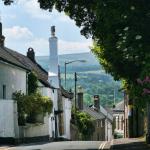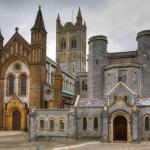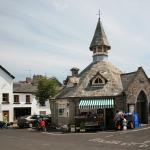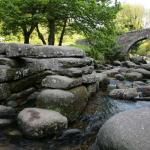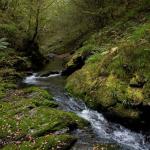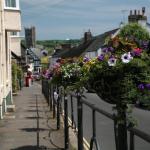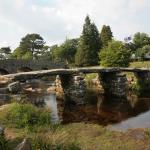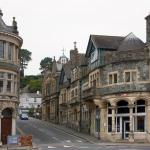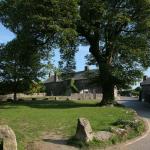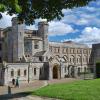The bleak beauty of Dartmoor National Park covers an area of 365 square miles. It is the result of an eruption of granite 250 million years ago, which lifted the softer rocks on the earth’s surface. This accounts for the weird and wonderful shapes left where the sedimentary rocks have eroded to leave the granite outcrops. The desolate high moor is only one aspect of Dartmoor. There are softly undulating hills on the lower levels, and lovely wooded valleys. There are also several forest plantations. Sheep and ponies graze the moor and there are several examples of early human habitation.
Among these remains are tombs, hut circles and standing stones from the earliest times, but there are also ruins of 19th century industrial projects from the days when tin and copper were mined in the area. Granite was quarried here too and evidence of that can still be found here and there on the moor. Some small cottage crafts still survive on Dartmoor, many revitalised by the upsurge in tourism. The rather spooky Dartmoor, evoked by Conan Doyle in The Hound of the Baskervilles, can still be found easily, especially on a day when the mist shrouds the moor.
Bovey Tracey is the gateway to Dartmoor for many visitors. About a mile to the west of the old market town is Parke, a restored 19th century mansion once the home of the Tracey family, where the headquarters of the Dartmoor National Park Authority can be found. The information centre provides everything the visitor needs to know. A walk through the parkland of the house leads through woodland and pastures down to the valley of the River Bovey.
Climbing up from Parke, the road winds steeply towards Haytor - easily recognised by its huge granite outcrops resembling the two humps of a camel. The tor is almost 1,500 feet high. Even though steps have been cut into the rock, it is still a difficult climb to the top. The views of the Teign Estuary and the English Channel are rewarding.
Widecombe-in-the-Moor is perhaps the most famous of the villages of Dartmoor, at least in part because of its church, which is known as the Cathedral in the moor. It is doubly famous because of the old song Widecombe Fair. The fair, which was originally famous for its livestock, is held annually in September but caters more for the tourist these days. There is evidence of several Iron Age and Bronze Age settlements around the village and the views are impressive. Hameldown Beacon, at almost 1,700 feet, dominates the skyline to the north. There was a beacon here in Elizabethan times.
The nearby hamlet of Buckland has several picturesque cottages nestling in the wooded hillsides. It is dominated by the small granite church, parts of which date back to the 12th century. A little further on is the small town of Ashburton, built around the fast moving River Ashburn. The town was originally a Saxon settlement which owed its development to the tin and woollen trades.
Moretonhampstead is the gateway to Dartmoor from the north eastern side of the moor. An ancient market town, it has recently developed into a popular centre for crafts such as pottery and woodturning. Not far away, on one side, is the pretty Devon village of Lustleigh, a chocolate box village unspoiled by time. In the other direction is yet another similar village, North Bovey.
The Dartmoor Pony is a descendant of the feral Celtic pony, an inhabitant of the moor long before the arrival of man. The numbers have dwindled in recent years and the original ones only exist at stud farms. Pure bred ponies are around 12 hands in height. The ponies seen wandering the moor are cross breeds. The ponies were used by the British to draw light chariots at the time of the Roman invasion. Later they were used as pack animals, carrying wool and peat or pulling small carts.
Grimspound lies between Hameldown and Hookney Tor and is the finest example of a prehistoric settlement on the moor. There are 24 round buildings enclosed by a nine foot wide perimeter wall. At Postbridge, a medieval clapper bridge spans the East Dart River and, not far away, is Powder Mills, the former site of a gunpowder factory where there are now various crafts persons.
Perhaps one of the most famous, if least attractive, aspects of Dartmoor is that it is home to the Dartmoor Prison. Established as prison for Napoleonic prisoners in 1806, the prison is the ugly focus of an ugly town. Princetown is the service town for the prison. It is a grim place, housing prison officers and their families. Many of the local buildings were constructed by prisoners. Among these is the rather drab church of St Michael.
Away from the grim sight of Princetown is Dartmeet, the place where the East and West Dart Rivers meet and flow through a lovely wooded valley. This is a particularly popular spot with summer visitors, but there are plenty of places around where one can still find solitude. There is another clapper bridge to be seen here. Not far away is Two Bridges. This is of great interest to scientists because of Wistman’s Wood, a fragile ancient woodland.
Okehampton is another town with a view of the moor. To the south of the town, High Wilhays and Yes Tor soar to heights of over 2,000 feet – the highest peaks of Dartmoor. About ten miles south west of Okehampton is the small town of Lydford, once one of the most important defensive sites of this part of England.
A medieval village lies hidden in the Dartmoor valley between Hound Tor and Greator. Hountor Village was excavated in the 1960s and there are the remains of a few primitive longhouses. The village is thought to have been deserted in the 14th century due to adverse climatic changes. The weather on Dartmoor was kinder in the days when it was originally settled.
It is impossible to mention all the villages and sites of interest on Dartmoor. It is a vast area, encompassing something for everyone. There are towns such as Chagford and villages such as Drewsteignton and Sticklepath – many delightful places with delightful names. And there is nothing nicer than to wander the lovely places of the moor on a lovely sunny day in June or July.
Show more ...

